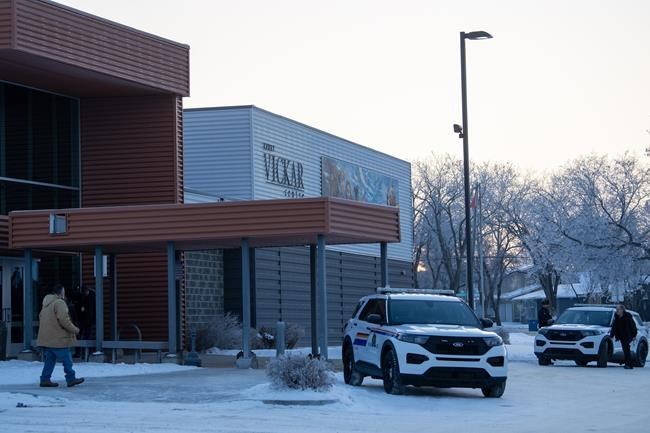MELFORT, Sask. — A mass killer built a makeshift camp in the bush, raiding a nearby home's garage for food and bedding, to hide from police after a deadly rampage on a Saskatchewan First Nation.
A coroner's inquest into the stabbing rampage on the James Smith Cree Nation and nearby village of Weldon, northeast of Saskatoon, revealed new details about how Myles Sanderson evaded capture for three days and seven hours after the massacre.
Sanderson killed 11 people and injured 17 others on Sept. 4, 2022.
People in the province were on edge for days as police followed every tip that might lead to Sanderson's whereabouts.
Sgt. Evan Anderson, with Saskatchewan RCMP's major crimes unit, said Mounties received around 600 calls with information about the killer, including tips from across Western Canada.
An emergency alert brought fear to Regina a few hours after the stabbings because of a possible sighting of the killer. But the inquest heard Sanderson was alone in the bush the whole time.
Soon after killing his final victim in Weldon, Sanderson drove a stolen truck into the ditch near Crystal Springs, a hamlet in east-central Saskatchewan near Wakaw. The vehicle had run out of fuel, the inquest heard.
Sanderson went to a nearby home. He snuck into the garage, raided a cooler for food and drinks, grabbed bedding and made a "camp" in the bush nearby, Anderson said.
"Myles Sanderson never left the Wakaw area," Anderson told the inquest, taking place in Melfort, Sask.
On Sept. 7, 2022, at 2 p.m., the woman who lived in the home called police. She said Sanderson had broken in and fled in her vehicle.
Police pursued the killer until RCMP ran the vehicle Sanderson was driving into the ditch near Rosthern.
The 32-year-old went into medical distress and was brought to hospital in Saskatoon by paramedics but was quickly declared dead.
Six jurors heard the final evidence of the inquest Monday. They are scheduled to receive instructions from the coroner Tuesday before deliberating on recommendations to help prevent similar deaths in the future.
A second inquest into Sanderson's death is to take place in February.
Over the last two weeks, the inquest has heard how the rampage unfolded from RCMP officers at the scene, major crimes investigators and health-care officials. It has also heard about Sanderson's life and prison history from his parole officers.
RCMP said in an overview of the massacre that Sanderson went to the First Nation to sell cocaine. In the days before the killings, he caused chaos with his brother, Damien Sanderson.
Damien Sanderson was the first to be killed. Myles Sanderson then went door-to-door on the First Nation stabbing people.
An RCMP criminal profiler has testified that some victims were targeted because Sanderson had a grievance against them, and others just got in the way of his mission to kill.
The inquest heard earlier Monday from Indigenous elders working in the Saskatchewan Penitentiary that Sanderson was unremarkable in the time he had spent behind bars.
"The first day I met him he was quiet," said Geraldine Arcand, an elder with the Correctional Service of Canada.
Arcand testified she was working as an intake elder at the penitentiary near Prince Albert, Sask., when Sanderson began his first federal sentence. She came up with an initial healing plan for him while he was incarcerated.
Arcand said Sanderson talked about issues, particularly from his upbringing.
"It was the anger that he feels," Arcand told the inquest.
Elder Harvey Knight, who ran a high-intensity program at the prison, said Sanderson spoke about his life almost like a child.
Knight said he could never have imagined the violence Sanderson was capable of.
"He didn't stand out whatsoever as somebody who was different."
Sanderson was serving a sentence of more than four years when he applied to the Parole Board of Canada for full parole and day parole in 2021. Both were denied.
Monica Irfan, a deputy director in policy and legislative initiatives with the Parole Board of Canada, said the board would have considered Sanderson's criminal record, including 59 convictions as an adult, along with his social history and release plans. She was not involved in Sanderson's file.
The board found Sanderson "will present an undue risk to society," Irfan said, reading part of that decision at the inquest.
Sanderson received statutory release in August 2021. Irfan said the board's role in statutory release, which kicks in when an offender has served two-thirds of a prison sentence, is to impose conditions.
Four months into his freedom, Sanderson was found to have been lying about his living arrangements, as he was staying with the mother of his children, Vanessa Burns. His release was suspended.
The inquest heard Sanderson's community parole officer had recommended he not be allowed back out based on his attitude and deceit.
In February 2022, the board cancelled the suspension and Sanderson again received statutory release with a reprimand. The board said it believed Sanderson's risk was manageable in the community.
Three months later, Sanderson was unlawfully at large and a parole officer issued a warrant for his apprehension. He was still at large at the time of the massacre.
The parole board and corrections agency conducted a joint investigation looking into Sanderson's release, but it was not made public ahead of the inquest.
The board said recently that the investigation would not be made public so as to not interfere with the inquest. The statement did not specify if the board was referring to one or both inquests.
Keith Brown, the lawyer representing the First Nation in the inquests, said the jury will have a lot to consider. But, he said, the narrow scope of an inquest will never address the large systemic issues at play.
"This process can only scratch the surface."
This report by The Canadian Press was first published Jan. 29, 2024.
Kelly Geraldine Malone, The Canadian Press



